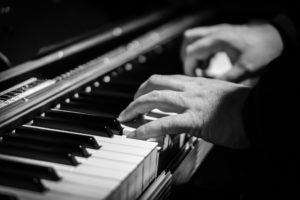An Introduction To The Primary Chords
Why will knowing how to play your primary chords boost your confidence quickly? My decades of experience as a piano coach have made it clear to me that the majority of piano beginners want the shortest path to immediate results possible. This is understandable since even small successes breed further enthusiasm and interest. So what’s the best way to go?
Well, there is more than one option, of course. That said, it is my perspective that if you can get a handle on just a few of the most often used chords, the fun you can have with them can have you enjoying many hours at that piano or keyboard of yours.
Here’s How To Know What They Are
So, what are the chords used most often? Well, quite simply they are the the chords that are built on the first, fourth, and fifth degrees of a given scale. Let’s look at the note names in the key of C Major:
C D E F G A B C
The first, fourth, and fifth notes (or degrees) in this scale are C, F, and G. We use Roman numerals to refer to these scale degrees. Therefore, we can refer to these three degrees of the scale as I, IV, and V.
Once we build a chord on these degrees, we have the following:
C Major, F Major, and G Major (illustrated below)

The key furthest to the left in each of these chords is the name of the chord. We call this the Root of the chord.
These three chords, the I chord, IV chord, and V chord, form the “backbone” of the key of C Major. You will notice that if you actually play all these chords at the same time (not practical), you are playing all the members of this scale.
The I, IV, and V chords are known as the primary chords, or primary triads, of the key (a triad is a chord that consists of three notes).
These Primary Chords Serve As Your Foundation
The great news? Once you can play these three chords, you can play a lot of songs! That’s right… countless tunes include just these three chords. Here’s even more good news: all the other chords you will learn have their basic foundation in these three chords. Once you have a handle on these three, you are actually in a much better position than you might currently imagine.
Okay, since you know that there certainly is value in knowing this chord “trio,” let’s not put it off any longer. It’s time to play them!
Free Video Shows You How To Play These Chords And More
Rather than getting into a “wordy” explanation of how, it makes a whole lot more sense to show you how to play them. You have the opportunity right now to learn how to play all your major chords (including these three, of course) in a way that is so simply, it’s almost silly. Simply click on this link and you will be taken to a page that will direct you toward instant access to this very special video.
Your Ticket To Playing Piano By Ear
Since these three chords are primary, they are more apt to be used in most songs. A person trained to play by ear automatically listens for the existence of these chords. So, by making it a priority to familiarize yourself with them, you’re doing a world of good for your musicianship.
Keep It Fun
You’re on your way, so have fun mastering these major triads! By the way, if you ever have a question, feel free to send it my way. I would love to hear from you.
-Dave

 To the beginner with little or no experience or even the classical player whose experience is limited to reading and interpreting the written page, I offer the same suggestions when it comes to being able to play piano creatively.
To the beginner with little or no experience or even the classical player whose experience is limited to reading and interpreting the written page, I offer the same suggestions when it comes to being able to play piano creatively. yourself verbally? Did you utter your first words after you learned how to read or write the letters of the alphabet?
yourself verbally? Did you utter your first words after you learned how to read or write the letters of the alphabet?